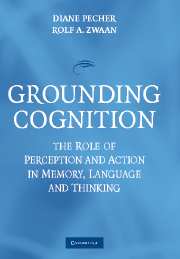Book contents
- Frontmatter
- Contents
- List of Contributors
- 1 Introduction to Grounding Cognition: The Role of Perception and Action in Memory, Language, and Thinking
- 2 Object Concepts and Action
- 3 Constraints on Spatial Language Comprehension: Function and Geometry
- 4 Embodiment in Metaphorical Imagination
- 5 Passionate Thoughts: The Emotional Embodiment of Moral Concepts
- 6 Grounding Language in Bodily States: The Case for Emotion
- 7 Situating Abstract Concepts
- 8 Dynamicity, Fictivity, and Scanning: The Imaginative Basis of Logic and Linguistic Meaning
- 9 The Emergence of Grammar from Perspective
- 10 Embodied Sentence Comprehension
- 11 On the Perceptual-Motor and Image-Schematic Infrastructure of Language
- 12 Connecting Concepts to Each Other and the World
- Author Index
- Subject Index
- References
11 - On the Perceptual-Motor and Image-Schematic Infrastructure of Language
Published online by Cambridge University Press: 22 July 2009
- Frontmatter
- Contents
- List of Contributors
- 1 Introduction to Grounding Cognition: The Role of Perception and Action in Memory, Language, and Thinking
- 2 Object Concepts and Action
- 3 Constraints on Spatial Language Comprehension: Function and Geometry
- 4 Embodiment in Metaphorical Imagination
- 5 Passionate Thoughts: The Emotional Embodiment of Moral Concepts
- 6 Grounding Language in Bodily States: The Case for Emotion
- 7 Situating Abstract Concepts
- 8 Dynamicity, Fictivity, and Scanning: The Imaginative Basis of Logic and Linguistic Meaning
- 9 The Emergence of Grammar from Perspective
- 10 Embodied Sentence Comprehension
- 11 On the Perceptual-Motor and Image-Schematic Infrastructure of Language
- 12 Connecting Concepts to Each Other and the World
- Author Index
- Subject Index
- References
Summary
Language is not a module. Well, at least, it is not a feedforward encapsulated domain-specific perceptual input system in the way that Fodor (1983) imagined. To be sure, there are regions of cortex that are conspicuously specialized for language-like processes (e.g., Gazzaniga, 2000; Kuperberg, Holcomb, Sitnikova, Greve, Dale, & Caplan, 2003; Ojemann, 1983), but when cognitive neuroscientists refer to these cortical areas as “modules,” they certainly do not imply solely feedforward synaptic projections or encapsulation from neighboring cortical areas. The vast and recurrent interconnectedness between anatomically and functionally segregated cortical areas (e.g., Douglas, Koch, Mahowald, Martin, & Suarez, 1995; Haxby, Gobbini, Furey, Ishai, Schouten, & Pietrini, 2001; Van Orden, Jansen op de Haar, & Bosman, 1997) unavoidably compromises any assumptions of information encapsulation, and can even wind up blurring the distinction between feedback and feedforward signals.
What this means is that we should expect language processes to function in concert with other perceptual, cognitive, and motor processes, not independently of them. For example, McGurk's famous and compelling demonstration of visual perception of mouth shape influencing the immediate percept of a spoken phoneme (McGurk & MacDonald, 1976) is emblematic of the intense degree to which speech perception and visual perception pay close attention to one another. More recently, visual perception has also been shown to play a strong role in spoken word recognition, syntactic processing, and reference resolution (Tanenhaus, Spivey-Knowlton, Eberhard, & Sedivy, 1995).
Information
- Type
- Chapter
- Information
- Grounding CognitionThe Role of Perception and Action in Memory, Language, and Thinking, pp. 246 - 281Publisher: Cambridge University PressPrint publication year: 2005
References
Accessibility standard: Unknown
- 9
- Cited by
